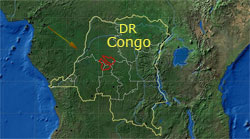 The
central region of the Congo Basin, the Cuvette Centrale,
comprises more than 800,000 km² of evergreen, tropical
lowland rainforest. Apart from the Amazonian Basin, it is
the largest rainforest
area on earth. The
central region of the Congo Basin, the Cuvette Centrale,
comprises more than 800,000 km² of evergreen, tropical
lowland rainforest. Apart from the Amazonian Basin, it is
the largest rainforest
area on earth.
The montane fringe areas are characterised by extreme species
diversity and phylogenetically young taxa. The central basin
is dominated by phylogenetically old taxa, with a high number
of endemic species of both flora and fauna.
Todays estimations of plant diversity comprise over 10.000
species, of which roughly 1.400 are endemic. The vast majority
of floristic knowledge has been assembled in colonial periods
during the 1st half of the past century (see Flore du Congo
Belge & de Rwanda Urundi). Since, little has been added
and major taxonomic groups still remain undescribed. Up to
now determination is hampered by lack of appropriate literature. |